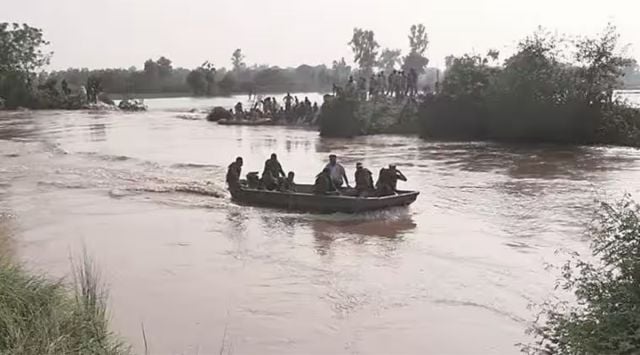Punjab proposes 6 small dams to control flooding caused by Ghaggar
To control the river's flow and to avert future floods, the Punjab drainage department has proposed construction of around six small dams at various locations, mostly within Haryana.
 Ghaggar, which originates from Dagshai village in Himachal Pradesh's Solan district, flows through Haryana and Punjab and finally ends up in Rajasthan. (Representational image)
Ghaggar, which originates from Dagshai village in Himachal Pradesh's Solan district, flows through Haryana and Punjab and finally ends up in Rajasthan. (Representational image) Ghaggar, a rain-fed river, has once again wreaked havoc on thousands of acres of agricultural land and damaged properties in hundreds of villages spanning across Mohali, Patiala, Mansa, and Sangrur districts of Punjab, as well as neighbouring Haryana, due to breaches in the embankments and overflowing caused by its narrow watercourse at several places.
To control the river’s flow and to avert future floods, the Punjab drainage department has proposed construction of around six small dams at various locations, mostly within Haryana.
Punjab, which will bear the construction costs, will also get the benefits of these dams. Sources in the drainage wing of the Punjab Water Resources department said that Ghaggar river narrows significantly at several points, leading to increased water levels and spillage during the rainy season, exacerbated by the influx of water from several local rivers that flow into it. A senior officer from the Water Resources department said, “We are proposing small dams at six locations, starting from the Tangri river, which flows into Ghaggar, till the gurdwara in Makror Sahib in Sangrur and other locations.”
He added that Ghaggar is a monsoon-fed, non-perennial river. Heavy monsoon rain in its catchment area — Mohali, Chandigarh, Panchkula, Ambala, Rajpura, Patiala, and Sangrur — results in the accumulation of water in the river. Additionally, its tributaries Tangri and Markanda also contribute to its water volume.
“Besides the construction of dams, improper cleaning of its drains, tributaries, the river itself hinders its flow,” sources from the drainage department said.
Officials from the department added that the river causes severe hardships for villages in Punjab and Haryana and both the states should collaborate to find a permanent solution to the frequent flooding. They said that installing proper dams along the entire river and constructing ring bunds in the villages that face flooding due to Ghaggar would help reduce losses. Widening of the river at various points is also necessary, they added.
Farmers of the affected villages due to Ghaggar floods said that even a little above normal rain led to overflow Ghaggar and their fields get inundated every alternate year. Several attempts were made to contact water resources and mining minister Gurmeet Singh Meet Hayer but he could not be reached for a comment.
Ghaggar, which originates from Dagshai village in Himachal Pradesh’s Solan district, flows through Haryana and Punjab and finally ends up in Rajasthan. The river and its tributaries, Markanda and Tangri, pass through Kalka, Panchkula, Ambala, and Kaithal (in Haryana) before entering Punjab’s Patiala and Sangrur districts. It then goes to Sirsa in Haryana, returns near Sardulgarh in Punjab, and ultimately enters Rajasthan, where it dries up.







